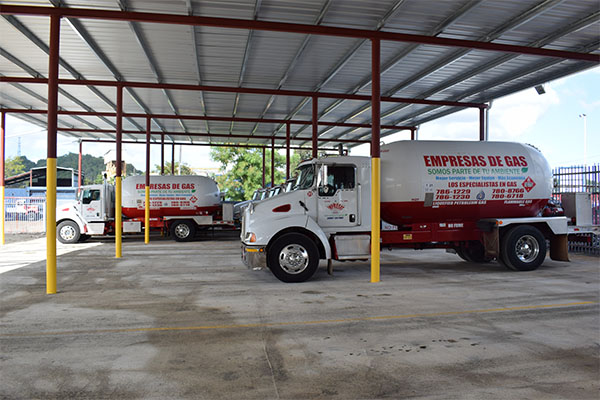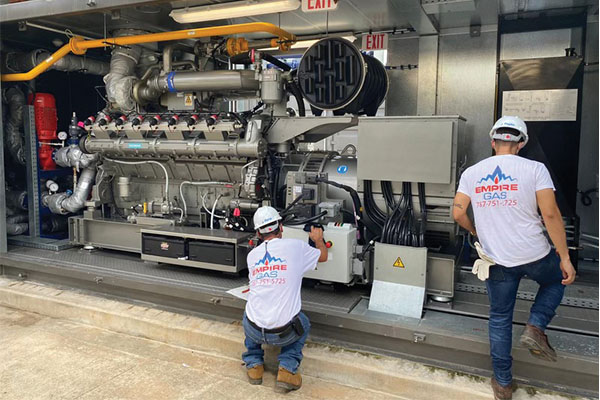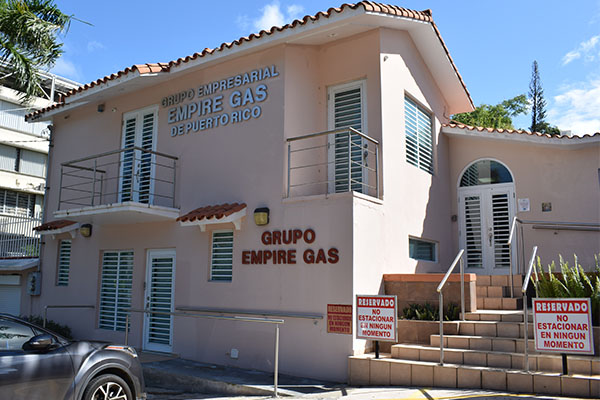Propane-powered CHP division augments retailer’s business model
We drive along the coast. In the distance stands El Morro, a massive fort built in the 16th century to repel enemies of the Spanish Empire. We turn down one of Old San Juan’s cobblestone streets to get a better view of San Juan Bay.
Ramón González Simounet, vice president and CFO of Empire Gas, and my host for the day, points to features on the horizon. We see the smokestacks of a power plant. He explains that many of these operate on diesel in Puerto Rico. The bay supports some industrial shipping and trade, including fuel imports, but much of the LPG his business distributes enters the island’s southern ports.
Invisible to us is a pipeline that runs in a ring below the streets of San Juan. Owned and operated by another of González’s businesses, San Juan Gas, the pipeline distributes synthetic natural gas, formed by mixing LPG and compressed air, directly to clients. Less costly to ship and distribute than natural gas, LPG and synthetic natural gas uniquely suit the energy needs of an island that imports all of its fuel, says González.
Propane’s importance as an energy source in Puerto Rico is apparent when we visit one of Empire Gas’ commercial operations. I watch customers load cylinders in trucks at the fill station. Most of the bobtails stationed at the site are on the road, delivering fuel to the company’s residential and commercial customers. The company serves every region of the island with 50 plants like this one. This particular operation moves 1 million gallons per month and is one of eight centers with bulk tanks across Empire Gas’ service area.
In 1988, the site consisted of a rented house on a 1-acre property. Today, the property spans 5 acres, and employees set up shop in the “house,” now a buzzing office space. That’s something of a theme in Empire Gas’ world – the San Juan home where González’s father founded the family business in 1967 remains the company’s headquarters.
‘Propane never faltered’

Empire Gas serves residential and commercial customers throughout Puerto Rico. (Photo by LP Gas staff)
As we tour the commercial operation, González bumps fists with masked employees who, he says, have stepped up as first responders during the pandemic.
COVID-19 lockdowns were just the latest in a series of emergencies Puerto Rico, and the company, faced during the past five years.
González praises one “do-it-all” employee at the operation for his round-the-clock service to customers in the aftermath of Hurricane Maria, which made landfall in Puerto Rico as a high-end Category 4 on Sept. 20, 2017.
The storm devastated the island’s electric transmission and distribution infrastructure, leaving 1.5 million customers without power for months and causing the largest blackout in U.S. history. By the end of 2017, nearly half of Puerto Rico’s residents were still without power, according to the National Hurricane Center. Almost a year passed before, in August 2018, the Puerto Rico Electric Power Authority announced it had restored full service.
Empire Gas’ propane service, in contrast, remained uninterrupted for the duration of the emergency.
“Propane never faltered with Maria,” says González.
In the aftermath of Maria, Empire Gas’ combined heat and power (CHP) division was a key contributor to energy resiliency. The CHP systems the company services use propane to produce multiple energies, such as electricity and hot water, for industrial processes and other energy-intensive facilities like hospitals.
While other hospitals shut down and evacuated, Hospital de la Concepción in southwest Puerto Rico remained operational and continued to receive patients thanks to a propane-powered CHP system supplied by Empire Gas.
Recycled oil producer Olein, another Empire Gas customer, installed a propane CHP system months prior to the hurricane and was able to restore service days after sustaining damage.
A Bristol Myers plant that manufactures cancer medication also weathered the storm with a CHP system. The CEO invited Empire Gas to a thank-you meeting at Bristol Myers headquarters for its role in supplying the required propane and maintaining production of life-saving medication, says González.
Innovating and preparing
One reason Puerto Rico’s electric utility wasn’t ready for the hurricane is it didn’t invest in innovation, says González.
That’s not Empire Gas’ plan.
Partway through our tour, we hop into one of the company’s propane autogas vehicles – another propane market Empire Gas serves – and drive just outside of San Juan to Vega Baja. We arrive at a propane-powered CHP plant Empire Gas designed, constructed and now operates for a Viatris pharmaceutical plant.
Customers like Viatris are attracted to CHP when they require reliable power to protect their products, explains González. Others seek cost savings and a better environmental profile.
“[These customers] want to have their own destiny in terms of energy,” says González. “They don’t want to be controlled by the government and by government energy rates.”
To meet the demand, Empire Gas established its own CHP division of 25 employees who provide engineering and technical expertise. The company has designed, constructed and now operates five propane-powered CHP plants. It supplies propane for another 20, and expects 10 to 15 more CHP customers to come online in the next year or two.
On-site at Viatris, we meet Marlon Cabrera, Empire Gas’ corporate engineering director. He shows me how one of these CHP systems work.

Empire Gas operates five propane-powered CHP plants. (Photo courtesy of Empire Gas)
Propane produces 4 megawatts (MW) of gas-to-electric power, while solar panels produce another 4 MW to supply total power to the pharmaceutical plant. In a process often referred to as cogeneration, the propane system simultaneously produces additional forms of energy for use at the plant: 1,000 tons of chilled water and 30,000 pounds per hour of steam and hot water.
Two 30,000-gallon bulk tanks supply propane to four Siemens SGE-48SM propane gas engines that convert gas to electric power.
Waste energy from the engine combustion is recovered to power four boilers that produce steam to clean and maintain conditions in the pharmaceutical plant. The boilers also run directly on propane and have replaced the diesel boilers that were used in the past.
The waste energy recovery system also produces hot water that is used for humidity control and process heating in the plant.
This hot water also feeds into an absorption chiller that produces chilled water for the plant’s air-conditioning systems and humidity control.
“Essentially, it’s free energy,” Cabrera says about the chilled water production.
The total energy efficiency of the CHP plant is 89 percent, compared to 18 percent efficiency for the grid, says Cabrera.
The CHP system’s energy efficiency and compatibility with renewable energies are a key part of its value proposition in light of a government mandate to reach 100 percent renewable power in Puerto Rico by 2050.
Another point of pride for Cabrera: These systems support clean-energy jobs for the people of Puerto Rico.

Photo by LP Gas staff
Journey to the top
Ramón González Cordero, father of Ramón González Simounet, founded Empire Gas in 1967 out of his family home, which still serves as Empire Gas’ headquarters in San Juan, Puerto Rico.
Approaching the 100-million-gallon mark, Empire Gas ranks No. 11 in LP Gas’ Top Propane Retailer rankings this year.
González Cordero was inducted into the LP Gas Hall of Fame in 2019.
















